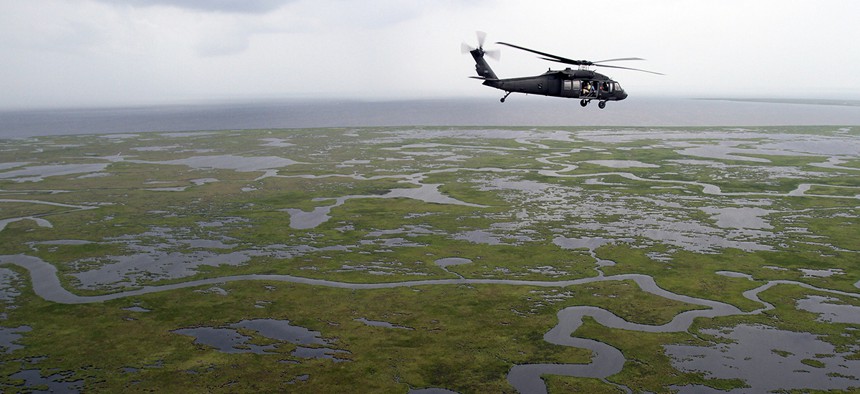U.S. Military’s Self-Flying Helicopter Program Passes Critical Test

Patrick Semansky/AP File Photo
Unmanned Black Hawks are coming. The goal is a major flight demonstration next year.
After nearly four years of research and development, the U.S.military is closer to helicopters that can fly themselves through unpredictable terrain and execute difficult missions with virtually no human input. It’s part of the Pentagon’s Aircrew Labor In-Cockpit Automation System, or ALIAS, program. Helicopter maker Sikorsky passed a key test earlier this month during an experiment at Fort Eustis, Virginia, involving an S-76B helicopter. The test demonstrated that Sikorsky’s software, called MATRIX, could take off, fly in difficult winds and at low altitude, avoid wires and other obstacles, and even make determinations about whether or not it is safe to land in one place or another. The goal, now, is to integrate the technology onto a Black Hawk helicopter next year.
In a conference call with reporters on Monday, representatives from the Defense Advanced Research Projects Agency, or DARPA, and Sikorsky (the Lockheed Martin-owned company that makes the Black Hawk) said that the goal of the program—really, honestly, truly—isn’t to replace human pilots. And they emphasized that operators participated in the event, in which engineers also tested the functionality and ease of the human-software co-pilot interaction. The goal is software that works with a human, in just the right way, so that pilots can hand over the task of flying, or aspects of it, with as little forethought as possible, in case the operator needs to do important mission planning, or check Instagram, or nap.
But program managers were also eager to describe how the software was able to do all of the things required of a competent pilot.
“The operator specifies a point [on a tablet PC] and says, ‘I need to land near a particular point on the map,’ knowing nothing; there’s no other a priori data. The aircraft basically makes a plan of how to get there, starts getting there. En route to that point, [it is] doing all the usual things like obstacle avoidance. So it’s doing full autonomous flight,” said Igor Cherepinsky, Sikorsky’s autonomy director.
It’s not the first unmanned helicopter, or even the first from the military. Back in 2011, the K-MAX from Kaman, was conducting supply missions in Afghanistan. In 2014, the company showed that the K-MAX could also dump water on forest fires. But those tricks are small compared to the elaborate machine vision and decision-making that Sikorsky and DARPA are claiming with MATRIX in this newest test.
“As it gets near the area, it starts to scan the area for feasible landing zones,” said Cherepinsky. If no suitable landing zones are present, MATRIX will take the helicopter around again, multiple times “to do what a human pilot would do, go around the pattern, come back, scan for some alternate areas and ultimately land. That’s one case of a fully automated flight with a whole bunch of emergent patterns, not predictable a priori.”
The software even executed a sophisticated mock reconnaissance mission. “The aircraft planned it, went down to a river canyon,” Cherepinsky said. “There were a number of obstacles that were not known beforehand, such as wires. The aircraft avoided the wires, [conducted] appropriate maneuvers going around, got to the point and came back, again completely without interaction from the crew.”
The next step, phase three of the program, will be more test flights and eventually the incorporation of more sensor data to further refine the autonomous piloting. DARPA and Sikorsky say that they are in contact with all of the services about how autonomous Blackhawks could be useful.
After that, similar to Predator drone maker General Atomics, they have their eyes on FAA certification to fly large, unmanned aircraft within the continental United States, to help ferry people and supplies from the mainland to offshore oil rigs, among other potential jobs. Today, large drones likes Predators are forbidden to fly over the U.S. except in a handful of largely unpopulated areas along the U.S. Mexico border.
The FAA is now figuring out how to change guidelines to allow unmanned planes and helicopters to fly over big cities. “We are working with the FAA on that. Our stated goal is 2030. It very much depends on rule making. We are certainly hoping for sooner, for the mid-2020s, to field it,” he said.






